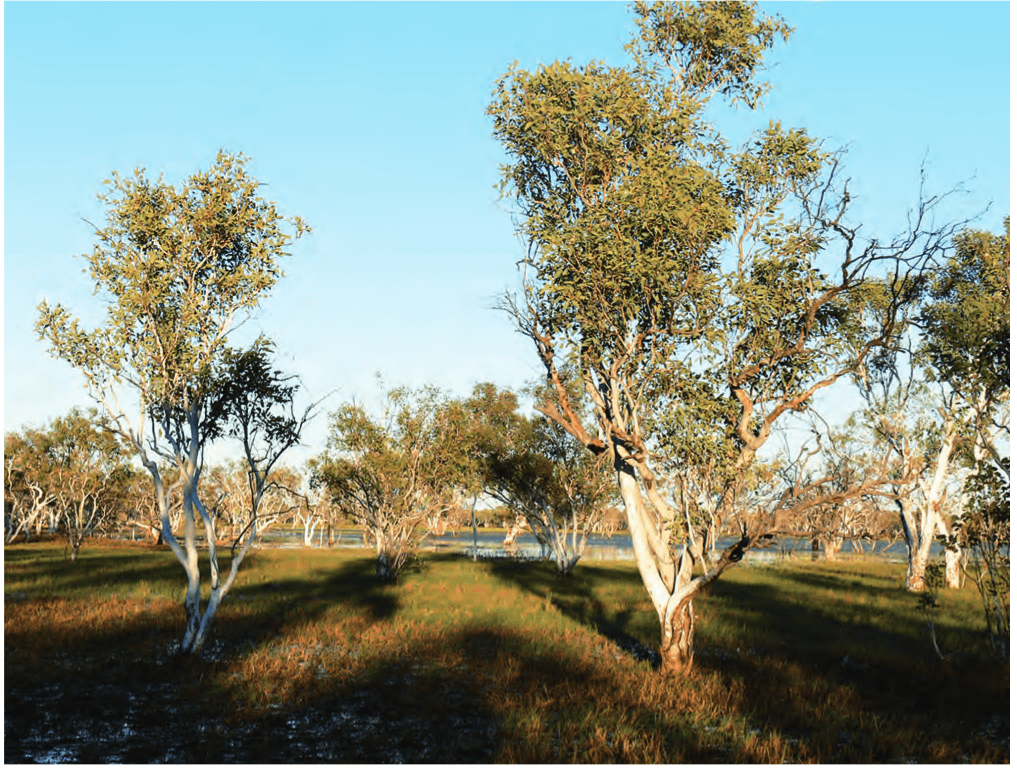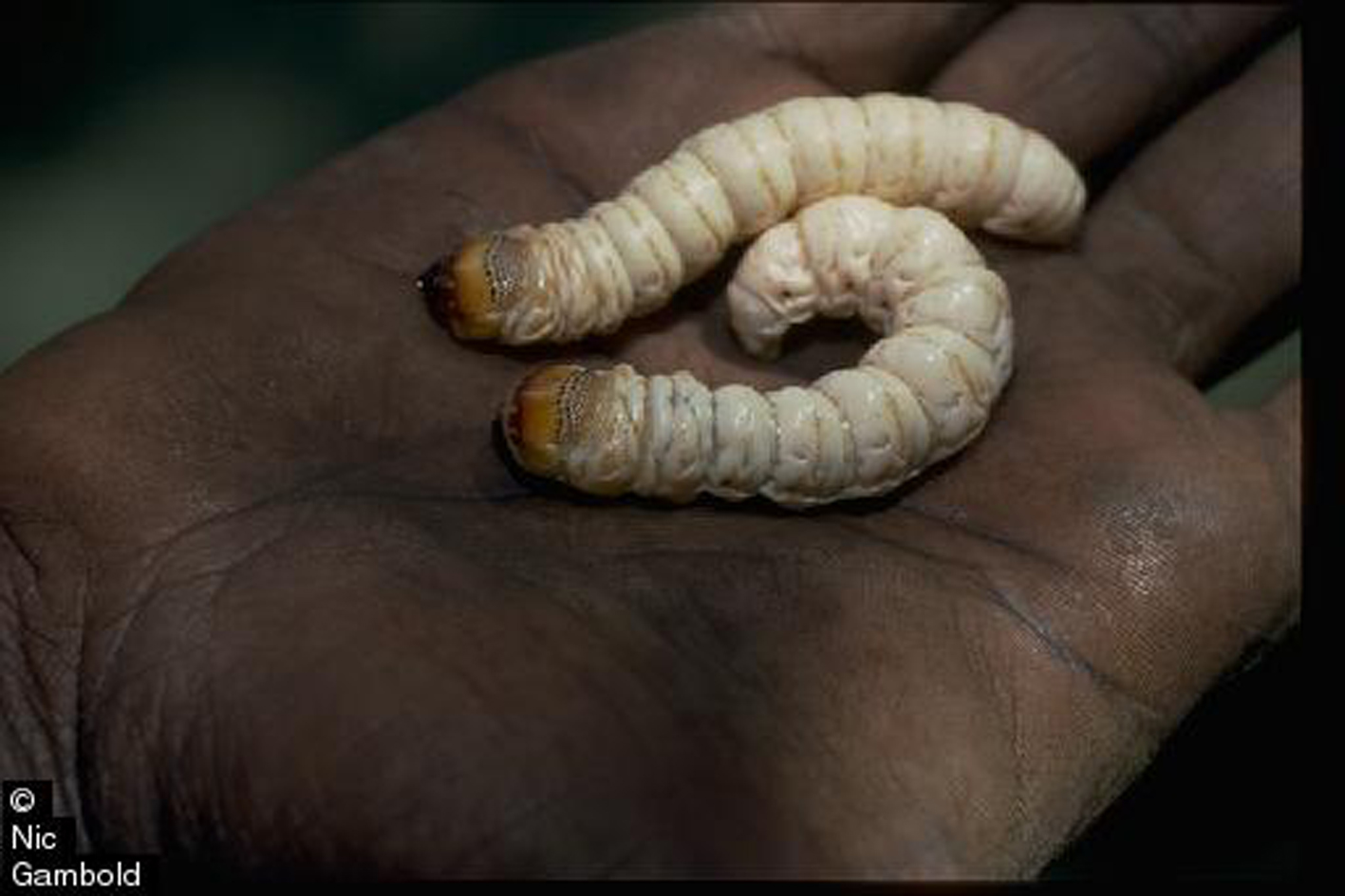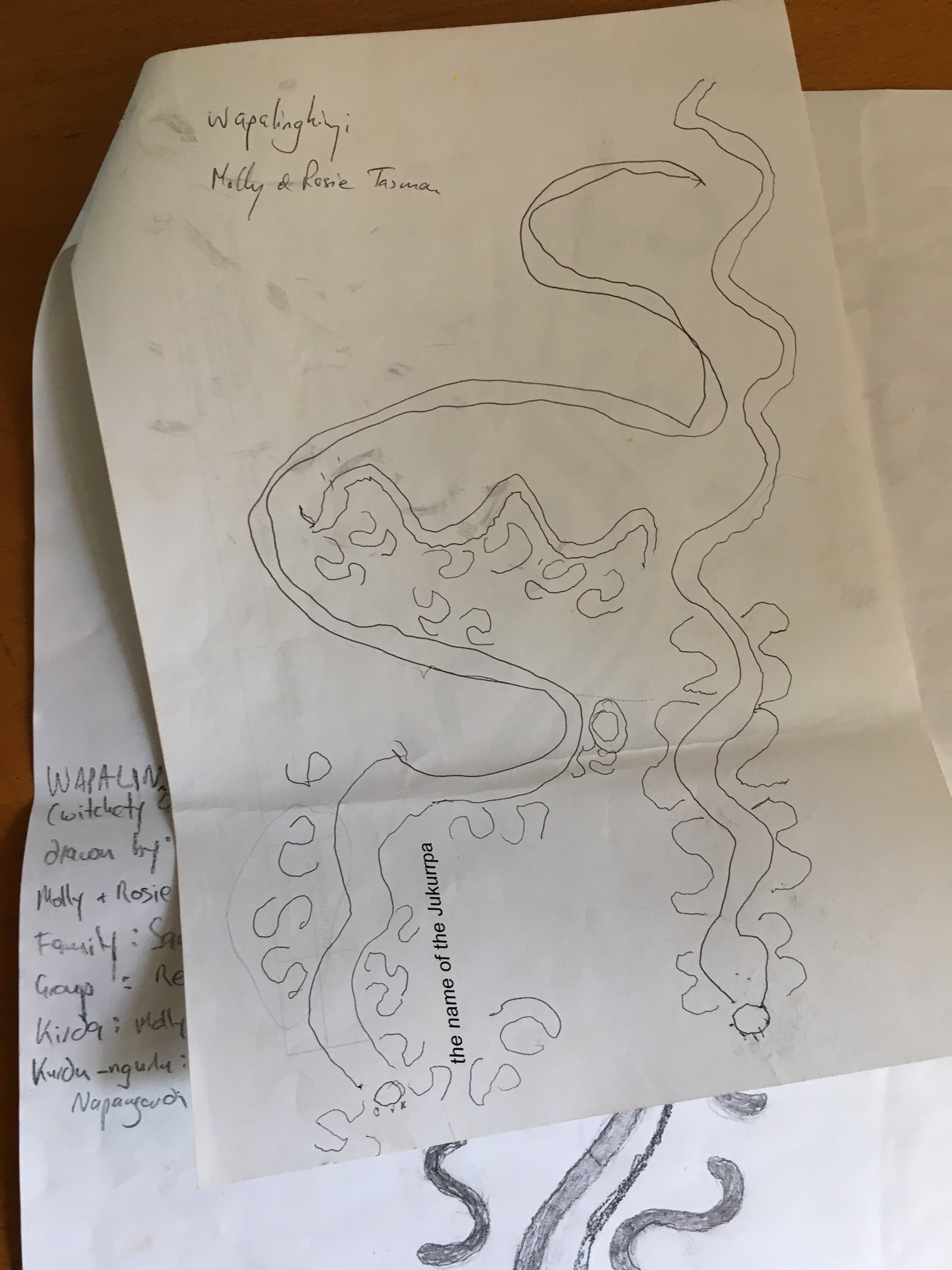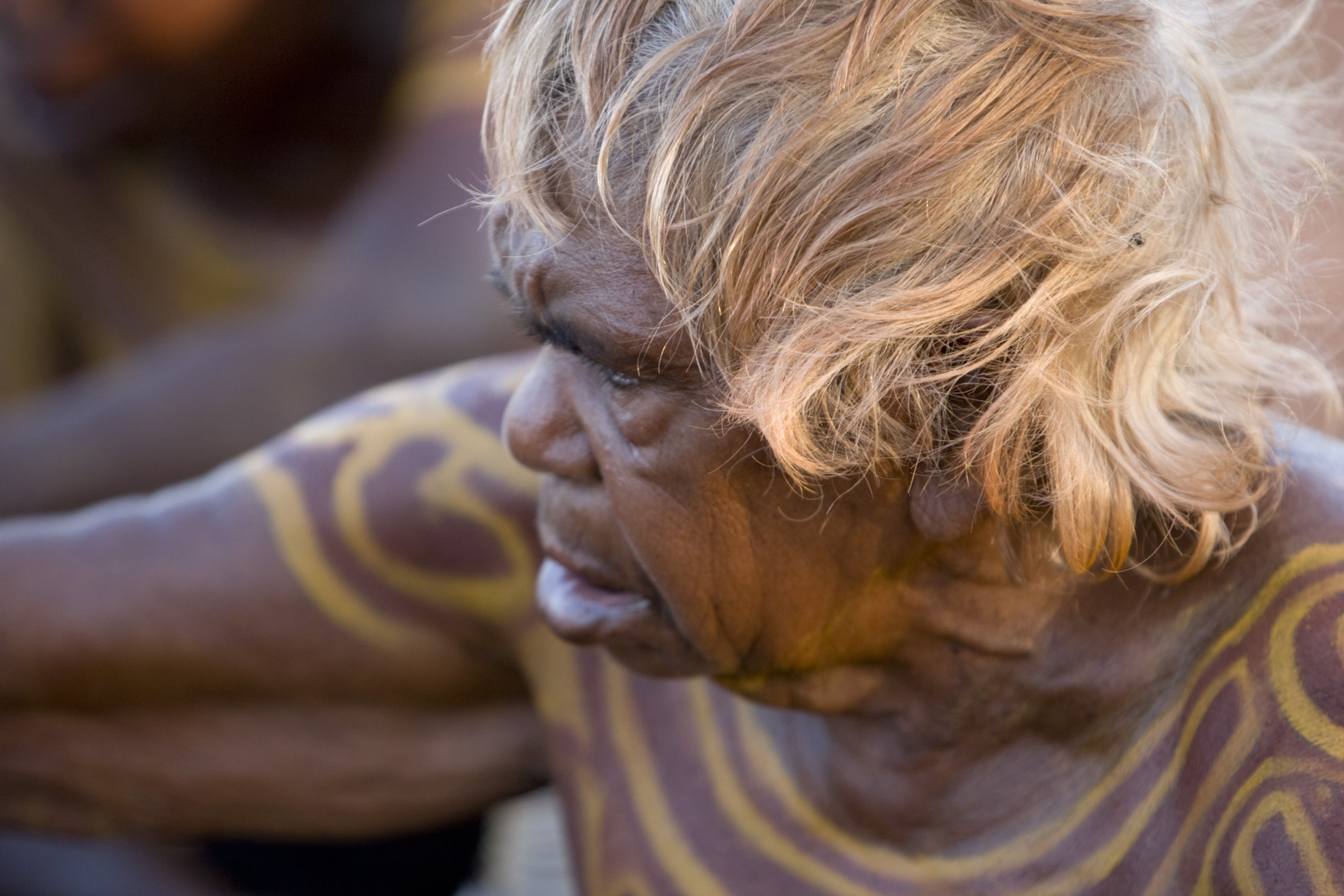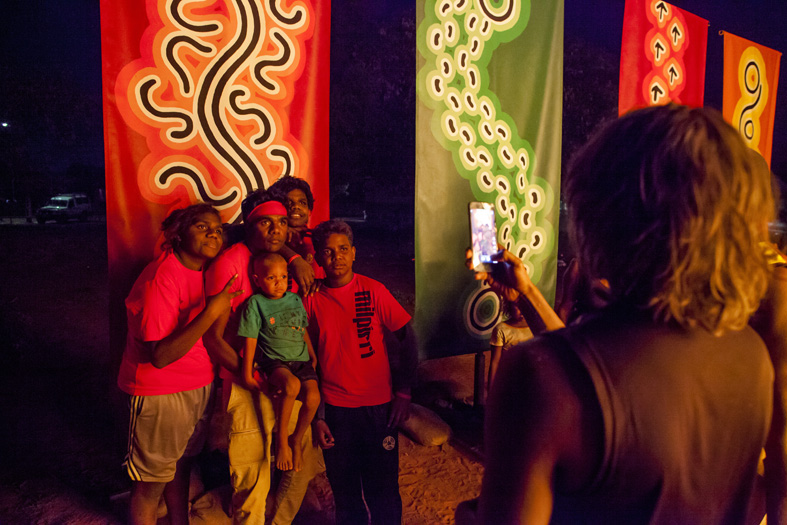Milpirri Banner - WAPILINGKI (Smooth barked coolabah tree)
Dreaming Design
This banner is Wapilingki, the Smooth Barked Coolabah tree. The central design is the trunk, and the circle is the top of the tree and also a place on the dreaming songline. The squiggly lines are the grubs which are found in the Wapilingki tree; the grubs are called wankilinyi. Warlpiri say they “belong to the tree.”
Latin
Eucalyptus Coolabah
Biology and Image
Wapilingki (smooth barked coolabah tree) - Photo / Information
Language Definition of wankilinyi
“edible larva found in Coolibah trees.”
Wankilinyi ngulaju laju wapilingkingawurrpa. Ngulaju pama karnalu yapangku ngarni.
Wankilinyi is a grub found in Coolibah trees. It is a delicacy which we people eat.
Dictionary Source: Laughren, M., K. L. Hale, and Warlpiri Lexicology Group, 2005 Warlpiri-English Encyclopaedic Dictionary. (Accessed Via Kirrkirr Interface to Electronic Files.) University of Queensland
Interesting Language Fact
Warlpiri divide food into Kuyu (meat), Miyi (vegetables) and Pama (delicacy). Witchetty grubs can be classified as kuyu or pama depending on the person. Pama is an edible food classified as neither vegetable nor meat. It is typically non-staple food supplied by insects such as flying termites or honey ants, and can include nectar, alcohol or tobacco.
Belonging to Skin Groups
Jupurrula, Jakamarra, Napurrurla and Nakamarra (Red Group)
Place
This dreaming is at a place called Jiparanypa and Miya Miya between Mount Davidson (Paralyu) and Lake Surprise (Yinapaka).
Find Jiparanpa on the South Tanami IPA. Either click on the "Jukuurpa Yirdiyi Kari-Yardiyi Kari" tab, or change to English and click on the "Jukurrpa map" tab. Look East towards Yinapaka on the Lander River - Map
Drawn By
Molly and Rosie Napurrula Tasman (dec), 2012
Family
Molly and Rosie Tasman Napurrurla (dec), Long and Chupp families.
Kurdungurlu
Gladys Napangardi Tasman (dec)
Artist Biography
Rosie Tasman Napurrurla: Napurrurla was born at Yarturlu-yarturlu [the Granites] circa1935. She is a Warlpiri speaker and lives at Lajamanu. Her country is Miya-miya and Malungurra and some of her Dreamings are Ngurlu (seed), Kaljirri (pigeon) and Karangu (name of country). Rosie started painting in 1986. Rosie’s knowledge of country is exceptional she has been a critical source of knowledge for heritage surveys and mapping the sacred sites of Warlpiri country. Rosie is very active in the formation and running of the Northern Tanami IPA and the North Tanami Ranger Group. She has been a prolific painter, artist, dancer, seed collector, ceremonial women, hunter and singer.
Source: Design and Art Australia Online with additions by Miles Holmes
Artist Biography
Molly Napurrurla Tasman. Born c.1936. Molly grew up in the Tanami Desert and lived at Mt Doreen, Yarturlu-yarturlu and Yurrampi. She lived a traditional life style as a young child. She was moved to Lajamanu with her family when the government relocated her people to the new community in the 1950s. In 2008 and 2011 Napurrurla was a finalist in the Telstra National Aboriginal & Torres Strait Islander Art Awards.
Language Stories
Wapilingki (synonym karrawari)
Wapilingki, ngulaji ka karrimi watiya wiri-wiri tarla-nyayirni karruwana manu pilipiliwana kujaka yangka ngapa ngunami. Ngulawananya ka karrimi wapilingkiji. Manu marluri-marlurirla. Ngurrju watiya wiri yamakuju. Manu ngurrju watiya kawurnpaku.
The Coolibah is a biggish really hard tree which grows along creeks and flat low-lying areas where there is water. That is where the Coolibah grows. And around claypans. The big tree provides good shade. And the wood is good for its ash (to mix with tobacco).
Wapilingki, watiya kujaka wapilingki karri, manu karrawari, ngapiripiyajukujala, palkaju, kala karrungkalku yangka pirntinyarrarla kujaka karrinja-yani. Manu wirrirlangurlajala ka karrawariji karrinja-yani wapilingki yuurrku. Ngulangawurrpaji kalu nyina pamayijala - lajuju ngulaju wankilinyi. Wankilinyi kalu ngarrirni karrawaringawurrpaju. Karrawari manu wapilingki-ngawurrpa. Ngulaju wankilinyi.
As for the Coolibah, the wapilingki or karrawari tree which is just like the river gum in appearance, but which grows on the banks of creeks and along gullies, it also contains edible grubs which are (called) wankilinyi. The grubs in the Coolibah tree are called wankilinyi. Those belonging to the karrawari or wapilingki tree are wankilinyi.
Wankilinyi ngulaju laju wapilingkingawurrpa. Ngulaju pama karnalu yapangku ngarni.
Wankilinyi is a grub found in coolibah trees. It is a delicacy which we people eat.
Dictionary Source: Laughren, M., K. L. Hale, and Warlpiri Lexicology Group, 2005 Warlpiri-English Encyclopaedic Dictionary. (Accessed Via Kirrkirr Interface to Electronic Files.) University of Queensland
Warlpiri Habitats
Warlpiri, like most people, divide the country into habitats, different groups of land, soil, plants and animals that live together. Wapalingki is present in a few Warlpiri habitats, generally sand plains, watercourses and swamps.
Read about Warlpiri habitats in this extract of the North Tanami IPA plan of management. The North Tanami IPA is managed by the Warlpiri rangers based out of Lajamanu - Information
Hunting anecdote
The grubs were pried out from the trunk with a hooked stick.
See a Warlpiri picture with old photos of hunting grubs in this school book. (English translation is at the end) - Download PDF


